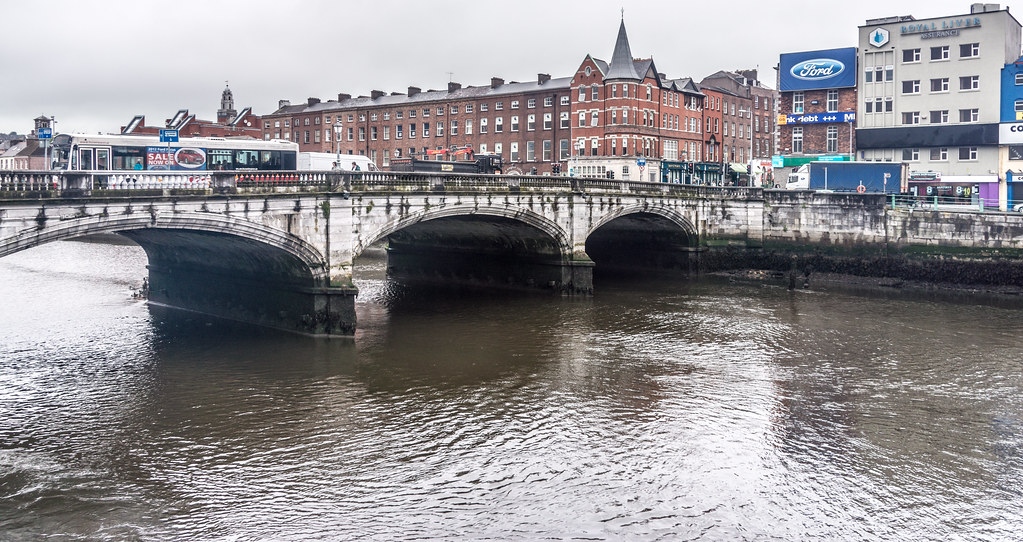St. Patrick's Bridge (1859) - Reconstructed In 1981
Effigies of Saint Patrick, Neptune, Saint Bridget, and three sea goddesses were carved into the key-stones of each arch by local sculptor Scannell
A three span masonry arch bridge which joins Bridge Street and St. Patrick's Street. This bridge has three elliptical arches and has ashlar limestone facing. There are carved effigies on the arch keystones.
The foundation stone was laid on the 25 July 1788 for the first Saint Patrick's Bridge. The structure was washed away while still under construction and had to be rebuilt. The bridge was opened on 29 September 1789.
This bridge was badly damaged in another flood on 2 November 1853 and a new bridge was designed by Sir John Benson. Cork Corporation were allowed to borrow funds for reconstruction of Saint Patrick’s bridge and Northgate bridge through the 1856 Cork Bridge and Waterworks act, so foundations were laid for Saint Patrick’s bridge in 1859. These foundations are 14' below the low water line and they support piers formed with iron reinforced concrete.
The main base and under-works were constructed of Foynes Limestone with good quality local limestone for the main superstructure, which is built of finely jointed ashlar. The foundation stone to the north-east abutment is a 2 ton block of Foynes limestone with a glass vase inserted, containing coins and scrolls of the mid 19th century and the names of local dignitaries and those chiefly involved in the bridge’s construction. A cost of £19,000 was budgeted for the construction. The Mayor of Cork, John Arnott, opened the second bridge on 12 December 1861.
Effigies of Saint Patrick, Neptune, Saint Bridget, and three sea goddesses were carved into the key-stones of each arch by local sculptor Scannell of Douglas Street. 100 stone cutters, masons and labourers were employed in building Saint Patrick’s Bridge.
The bridge carried trams which were horse-drawn from the 1870s and became electrified from 1898. During reconstruction works on the bridge in 1981, all but a small number of the carved parapet balusters were replaced with concrete. Cast iron lamp standards provided gas lighting from 1861 but replacement, double, electric lanterns now serve the bridge-way from stone pedestals on the parapet.
The foundation stone was laid on the 25 July 1788 for the first Saint Patrick's Bridge. The structure was washed away while still under construction and had to be rebuilt. The bridge was opened on 29 September 1789.
This bridge was badly damaged in another flood on 2 November 1853 and a new bridge was designed by Sir John Benson. Cork Corporation were allowed to borrow funds for reconstruction of Saint Patrick’s bridge and Northgate bridge through the 1856 Cork Bridge and Waterworks act, so foundations were laid for Saint Patrick’s bridge in 1859. These foundations are 14' below the low water line and they support piers formed with iron reinforced concrete.
The main base and under-works were constructed of Foynes Limestone with good quality local limestone for the main superstructure, which is built of finely jointed ashlar. The foundation stone to the north-east abutment is a 2 ton block of Foynes limestone with a glass vase inserted, containing coins and scrolls of the mid 19th century and the names of local dignitaries and those chiefly involved in the bridge’s construction. A cost of £19,000 was budgeted for the construction. The Mayor of Cork, John Arnott, opened the second bridge on 12 December 1861.
Effigies of Saint Patrick, Neptune, Saint Bridget, and three sea goddesses were carved into the key-stones of each arch by local sculptor Scannell of Douglas Street. 100 stone cutters, masons and labourers were employed in building Saint Patrick’s Bridge.
The bridge carried trams which were horse-drawn from the 1870s and became electrified from 1898. During reconstruction works on the bridge in 1981, all but a small number of the carved parapet balusters were replaced with concrete. Cast iron lamp standards provided gas lighting from 1861 but replacement, double, electric lanterns now serve the bridge-way from stone pedestals on the parapet.
SORRY FOR THE DELAY
THE PHOTO DIARY IS NOT LIMITED TO CORK AS I ONLY VISIT THE CITY ONCE EVERY YEAR AND 2020 MAY BE AN EXCEPTION. I AM BASED IN DUBLIN BUT DURING THE SUMMER MONTHS I VISIT BELFAST, LIMERICK, GALWAY, KILKENNY AND WATERFORD AND USUALLY DEVOTE A WEEK TO PHOTOGRAPHING EACH OF THE CITIES IN QUESTION
You will find links to buy products from Amazon, Google and other partners. If you click on these links, you’ll find that the URL includes a small extra piece of text which identifies that the click came from my websites. This text is an affiliate code, and it means that I get a small percentage of the money you spend if you choose to buy that product, or, in some cases, other products from the site soon after. These affiliate links help pay the costs of producing my websites and ensure that the content is free to you.


